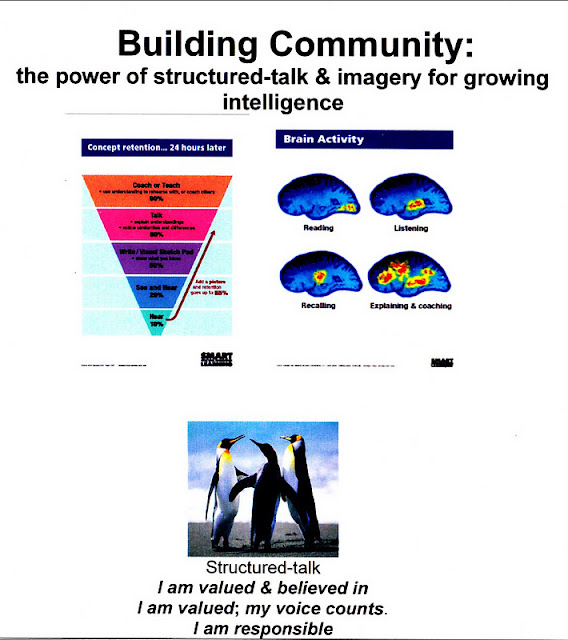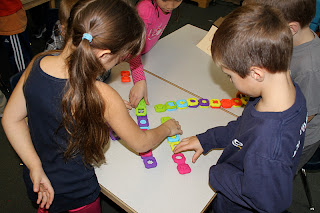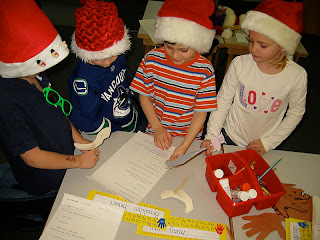It was so cute when the teachers kept filling in the room and my students were counting the teachers. It didn't even seem to phase them that they had twelve other teachers watching and listening. Div. 18 did such a fabulous job teaching the teachers what grade ones can do while using SmartLearning Tools!!! Many of the teachers could not BELIEVE they were grade ones and in November no less!!!
People often ask... What is SmartLearning? There doesn't seem to be a very simple answer as I'm fairly new using SmartLearning Tools, but so excited about how is has changed teaching and my classroom environment! All I know for myself as a Teacher is that SmartLearning has changed the 'Image' of children for me and what they are capable of doing. Giving them the opportunity to express and develop their learning has opened so many possibilities for our class learning. Not only has it made learning exciting and fun for my students but for me as well. I would never go back to the senseless drill worksheets again!!!
Here is a simple explanation from the founder of SmartLearning Susan Close (2011):
Please note any of the SmartLearning Images are © Susan Close Learning, 2011
*SmartLearning sequences are designed with complex thinking in mind, thinking that encourages more sophisticated levels of understanding. We develop novel contexts and roles around the tasks. Learners are invited to think in role, as observers in the situation, characters in the setting… experts or authorities immersed in important information… The novel roles pique interest and set the stage for rigorous work ahead.
Demonstrations of thoughtful literacy require readers to be able to ‘Consider, Discuss and Talk’ about their ‘Understanding of Text’, and also about the Various Processes of Reading.
Students need many opportunities to interact with text, with partners and with ideas presented to the whole class… explaining connections, summarizing, synthesizing, analyzing and evaluating ideas.
A/B Talk:
In SmartLearning classrooms the teacher carefully structures partnerships to develop skill with social interaction. The social interactions are designed to build social intelligence – the skills of social awareness and social facility:
Social Awareness
· Feeling with others
· Sensing non-verbal emotional signals
· Listening with full receptivity
· Understanding another person’s thoughts, feelings, intentions
· Knowing how the social world works
Social Facility
· Interacting smoothly at the non-verbal level
· Presenting ourselves effectively
· Shaping the outcomes of social interactions
· Caring about others’ needs and acting accordingly
Brain Activity:
Least: when reading silently, without applying a thinking strategy or considering a complex task
More: when asked to make connections to own experiences, to their texts, or to something in the world
Most: when you are invited to explain your understandings
Brain Fact:
Learners retain new information by activating what they know. Working memories are set down as circuits to be activated when needed.
The more pathways there are to connect with previously learned knowledge, the more rapidly it will be retrieved.
-------------------------------------------------------------------------------------------------------
Our most important learning began when we started building our 'Class Community'! See class blog for more details on the books we began our SmartLearning adventures with... (see Oct. 30 Class Community)
As a class we started out the year working on A/B partners first. We did it step by step with clear instructions. Students sitting knee to knee and eye to eye. They caught on well when it was time to report out. I love A/B partners as one person in the partnership reports out what their partner says! Wow... they really listen because they just can't make it up when reporting out. Of course there are those that forget and then we give them a chance to leave the room to rehearse and try again!
Learning how to listen to our partners...
My partner (name of child) says/thinks __________________
Then we practiced using the 'Coaching Cards' and talked about being 'Powerful Readers' and needing to use both sides of our brains. When we are using both sides of our brain we are thinking in words and images! When we read we must make images in our brain or we are not reading... we are just decoding and not understanding what we are decoding.
Powerful Readers...
The coaching cards are double sided...
Right Side of the Brain:
It is very important not to forget that developing readers need to pay attention to images in the book and create images in their brain to help them understand the story and be able to access prior knowledge, make connections, understand what is important and be able to ask questions while reading.
These picture prompts help students to focus their ideas and help them communicate their images and wonderings. We also use these prompts to be 'Powerful Writers" as powerful writers use feeling words, descriptive words like size, colour, smell etc. to paint a picture with words for the reader. That is how we can jump into a different world with 'Powerful Writing'!
Left Side of the Brain:
When we are using the left side of our brain we are using sequencing, word and ordering side of our brain. When we use this side of our brain it helps us to infer information from the story parts that are not actually written but implied by the author through words not written and the images presented. We also learn to ask questions, check for information and recheck and look for important information.
When being 'Powerful Writers' we must include these areas in the story in order for it to make sense and grab the attention of the reader.
Now that we introduced the coaching cards we started adding 'Juicy Words' to our SmartLearning Word Wall, which is beside our regular word wall... We even have some words in 'jail' like sad and happy. This means students can't use these in their writing and need to use a juicy word from our list instead to create better images in our writing!
Each time we learn a new SmartLearning Tool we then in corporate it into other books we read. It gets them moving and talking about our thoughts and what we are learning. We often forget that the B.C. Ministry requires primary grade to have a certain percentage to be learned and expressed in oral language through discussions and reporting out.
Div. 18 knows how important it is to create and describe images as it creates pathways and connections in our brain. The more pathways and connections we make the easier retrieving information is and therefore, learning becomes easier. Ask your child about neurons firing and dendrites!
Samples from our Nov. 8th Learning Round: This was their second time participating in a SmartLearning Sequence - Several lessons that are done over days or weeks with one particular book. Taking time to have fun with a book and going deep within the message of the book with the characters.
Book: Can I Play Too? By Mo Willems
Connecting:
Day 1: Nov. 8, 2011:
Note: The more time we spend on connecting the more powerful their writing becomes!!!
*Give Goal: Today your going think like the characters in the story and think about what
they are thinking, saying and feeling as they solve a problem.
*Goal Setting: Students set a goal for themselves for listening and participating.
*Hidden Object:Where students use the Purple Side of the coaching card (Left Brain Side) to visualize and ask yes/no questions... (i.e. Can it run? Is it blue? Is it soft? etc.) We keep a running tally. Once they get to 10 clues out of the 20 yes/no possible questions they may look at all the clues and guess what it is. If the tally gets to 20, I will, but some how they always guess and they love this game!
* Connection: Think of a time when you wanted to play with someone and couldn’t play or didn’t know how to play the game. How did it make you feel when you couldn’t play? How did you react? What did you do? A/B partners and report out.
Some Student Sample Videos:
*Building From Clues: Painting a picture for your partner. Partner A sits facing their partner’s back with picture 1. Partner B sits facing away with a coaching card. First min. partner A tells partner B all the things they see in picture 1. After one min. partner B is able to ask questions using the coaching cards. Tell me more about the motion, feelings, colour or textures etc. Then partner A shows partner B the picture. Always use our manners and say thank you for sharing your picture. Then partner B discusses what was the same, different than the picture in their mind (what they notice). They also discuss what they wanted to know more about. Give 30 sec. rehearsal time for partner B to practice then report out. Then vice versa for the second picture.
Note: Normally we would stop the sequence here for the day... but we had visiting teachers, therefore, we kept going so they could see as much of the sequence as the kids and time would allow.
*Word Work (in A/B Partners): Using the words given from the story students will sort the words into categories and give rule for sorting.
*Prediction & Building From Clues: Using at least three of the words along with the pictures come up with a prediction that holds all the clues together. (Use Coaching Cards or desk strip) Students report out orally.
Story starter: On day....
Some video samples of their Story Prediction from using picture and word clues...
| |
Processing Information:
Day 2: 30 -45 min. (Review the pictures and word clues from previous lesson)
Front Cover: Show the front cover as students are in whip around formation. What problem do you think the characters may have in the story?
Chunk 1: Read story to page 10: In A/B partners students walk and talk about what the characters maybe thinking, questioning or feeling. Discuss as a group what the characters maybe thinking, questioning and feeling. Have students come up as the characters and use thinking, questioning and feeling bubbles.
Chunk 2: Read story to page 12: Read what snake says to Piggie and Elephant. Have students go back individually and fill in the thinking and feeling bubbles. When students are done they need to share with three teachers in the room.
Day 3: 30 - 45min. (Review connections and thinking bubbles from last day. Reread story from beginning…)
Chunk 3: Read story to page 17: Hands on/Minds on Activity
1) Cotton ball race problem (students are not allowed to use their hands to move it) How will they move it?
2) Puzzle problem (students work with one hand each only to solve the puzzle problem.
3) Tangram (without talking try to figure how to put the pieces back into a square.)
Students report out how they solved the problem and how over coming the challenge made them feel.
Pom Pom Game: http://youtu.be/XLtzOLBa2fg
Tangram Game: http://youtu.be/T_NHnxatXPU
Puzzle Game: http://youtu.be/wqG4ZtQaFyI
Day 4: 30 – 45min. (Reread story from beginning and continue…)
Chunk 4: Read story to page 44-45: Role on the wall. Students in A/B partners use sticky notes to tell how the characters are feeling (heart sticky), thinking (green cloud sticky) and tell what is happening in the environment (star sticky) around the characters.
**Sample of sharing out of 'Role on the Wall': http://youtu.be/qBiMMGA0Lz0
Day 5: 30 – 45min (Reread story from beginning and continue…)
Chunk 5: Read story to page 55: “She has an idea.”- what questions do you might have or wonder how Piggie is going to maybe solve the problem?
Sentence frame: Piggie, Elephant and Snake can _____________
Whip around share... standing in a circle each child shares out their ideas about how Piggie, Elephant and Snake solved their problem...
Day 6: 30 – 45min: Making Characters and Reading Texts...
Chunk 6: Eyes on Text: Have students follow along orally with the story as a class. Any other readings you could do round robin reading in A/B partners or small groups. Have students rehearse a page or section before reading out to the class. Depending on the grade level you may just choose one page or more. It could also be done as Reader’s Theater in groups of three.
Day 7 & 8 Practicing and Presenting...
Making "Puppets" through directed drawing:
Can I Play Too? Presented by Isabella, Hayley Anne, Hannah:
http://youtu.be/FG00Umn61d0
Can I Play Too? Presented by Paige, Cam, and Sabina:
http://youtu.be/gfFpXlGYC-Q
Can I Play Too? Presented by Peter and Lukas G.
http://youtu.be/anYuYB6gRG4
Can I Play Too? Presented by Jake H. and Olly:
http://youtu.be/EFNpZQFKf1M
Can I Play Too? Presented by Lukas B, Mya and Ben:
http://youtu.be/HXHGpx80qcI
http://youtu.be/KKJ_9ccfVY8
Transforming Learning:
Day 9: 30 – 45min
Give advice to a friend: “What advice would you give your friends if your friend didn’t want to play the same game, or couldn’t physically play it like you can?”
Math Connections: Open-Ended Math Problems...
How do you know? Explain your thinking... Show me another way!



























































